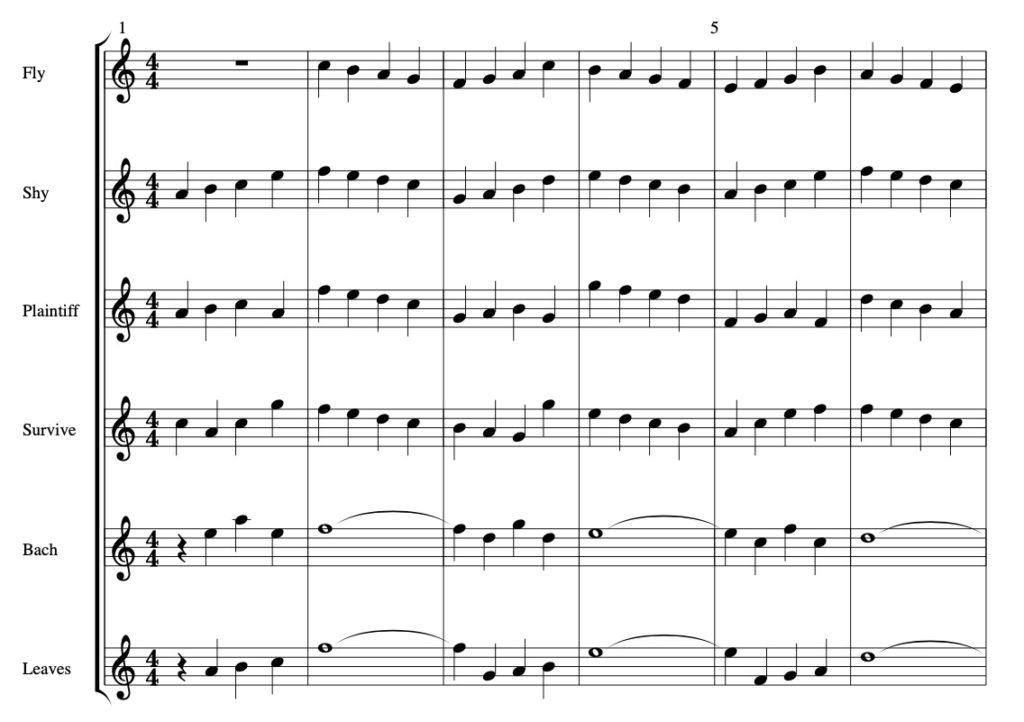
And she’s being sued by a flautist for heaven’s sake.
René Lorente is a 74 year old Cuban-American flautist suing Karol G because here 2023 hit “Don’t Be Shy,” which she wrote and recorded with world-renowned DJ Tiësto, does indeed bear a resemblance to Lorente’s “Algo Diferente,” which he recorded in 1998, when she was seven.
Karol G has gone all the way from appearing on the Colombian version of The X Factor, to collaborations with the likes of Bad Bunny, Daddy Yankee, J Balvin, Nicki Minaj, and Shakira. She just had a new record land on Billboard’s top ten albums. Today, she has moved into the number one spot on Billboard’s Hot Latin chart, replacing another song of her own, and as we’re hearing about this lawsuit, she’s on the cover of Rolling Stone magazine.
I find myself actually kinda ticked off that something like this comes along and might be bothering her. How many times are you gonna be the cover of Rolling Stone?
According to the complaint, Karol G’s “Don’t Be Shy,” which is her first song entirely in English, and “Algo Diferente” share “distinctive melodic elements, harmonic progressions, harmonic and lyrical structures that attest to a direct relationship between the two compositions.”
But Mr. Lorente is mistaken. I’ll explain it; you’ll understand it; and we’ll do a bit of music appreciation and theory while we’re at it. It’ll be fun.
First, here’s “Don’t Be Shy” and “Algo Diferente.” Once you’re a minute or so into “Algo Diferente” you’ll know why we’re here.
You probably hear it. The hook in “Don’t Be Shy” has a lot of notes in common with “Algo Diferente.” That’s why we’re here.
But we shouldn’t be. Might take me seven or eight minutes to explain why.
Copyright infringement requires a combination of things: copying and unlawful appropriation, which are combinations of things themselves, but we can keep it simple. The first piece is copying, and that requires “access,” because you can’t copy something you’ve never heard. You might write the same song completely by chance, but the sameness doesn’t make it copying. Coincidences are specifically NOT “copying.”
The plaintiff must first prove Tiesto and Karol G had access to Algo Diferente, and defendants like to fight this first battle especially hard. If they can knock out “access,” it’s put your pencils down time. So is there any good reason to believe Karol G ever heard this flute song? I don’t know. Maybe, maybe not. I haven’t had time to evaluate Algo Diferente’s reach; this whole story just came out today and we’re digging right in. Let’s just assume she won’t admit to knowing “Algo Deferente,” because, well, she won’t, and Tiesto either. That’s when the plaintiff needs a forensic musicologist to write up a musicologist report that will say something like, “‘Don’t Be Shy’ is so very similar to ‘Algo Diferente’ that the only reasonable explanation is that Tiesto and Karol G must have heard ‘Algo Diferente,’ and therefore we must infer that there was access. Low and behold, I have acquired the filings, and indeed, that’s what they’re saying.
Then comes the “unlawful appropriation” part. It’s short for “your song contains something original to and protectable by Algo Deferente, and it’s enough that polite society should ding you for it and compensate Mr. Lorente.” Which is pretty much the same argument allows a forensic musicologist to infer access, right? So the process is actually not so step-by-step. It’s more convolved.
Remember what copyright does and does not protect. Here, taken right from the copyright office’s website:
Copyright, a form of intellectual property law, protects original works of authorship including literary, dramatic, musical, and artistic works, such as poetry, novels, movies, songs, computer software, and architecture. Copyright does not protect facts, ideas, systems, or methods of operation, although it may protect the way these things are expressed.
https://www.copyright.gov/help/faq/faq-protect.html
One piece of forensic musicology that exonerates Karol G and Tiesto is called “prior art” which I mainly employ to evaluate and demonstrate the matter of originality. If I find that the musical elements shared by two works exist in older works, then the element may not be protectable by the copyright holder of that work, and in the case of public domain works, say, something Bach wrote in the 1700s, it’s likely protectable by none.
And in this case, prior art is just jumping into my head without my even trying.
One good reason Karol G and Tiesto have a hit with “Don’t Be Shy,” is its use of sequencial ideas along the circle of fifths. It’s instantly familiar and appealing and you’ve heard this device a lot.
These are all circle of fifths progressions. Let me quickly explain what that is. Consider this series of letter names, no sharps or flats, no major or minor’s, just some letters. We only use seven letters for note names; A-B-C-D-E-F-G. That’s alphabetical order, obviously. The circle of fifths is just putting them in a different order such that we start on A, count back five to D, count back five to G, and so forth until we arrive back at A. And it just keeps going like that…
A – D – G – C – F – B – E – A – D – G – C – F – B – E – A – D – G – C – F – B – E – A
It sounds like this… first just the bass line, and then the usual sort of harmony that goes along with it.
It’s in all those songs above, and it’s been going on for a long time. Nobody doesn’t love Bach’s Brandenberg Concertos, and certainly, this is one of Brandenbergs’ most familiar melodies.
Oh, duh! “I will survive!”
The plaintiff’s song, and the defendants, are like all of these — sequences around the circle of fifths.
I keep using that word, “sequences.” Let’s explain that. I’ll illustrate with some do re mi’s.
In music composition, sequences are repetitions of a musical figure, shape, idea, whatever, at different pitches. Think about the melody, “fly me to the moon and let me play among the stars.” The words “fly Me To The Moon” are sung to “do ti la sol fa.” That’s just the scale descending in order, right? Starting on do and going down through the notes to Fa, five notes from where we began. Then imagine the next line, “play among the stars,” which will start on Ti and go down five notes lower till it hits mi. “Ti la sol fa mi.” The next line is ” let me see what spring is like on Jupiter and Mars. The words “Let me see what spring” are the third sequence — you guessed it, starting on La and descending five notes to Re.” Then “is like on” is a brief upward melody followed by the five syllables “Jupiter and Mars” which are, would you believe it, a five note figure descending right back down to Do.
That’s why the tune is cool. True of all of these. One of the ways music works.
Now return to the plaintiff’s song with these ideas in mind and listen for the sequencing.
The melody is
la ti do la…
fa, fa mi re do ti
sol la ti sol… (now it’s gonna jump up the whole scale to the sol eight notes up)
sol, sol fa mi re do
and so forth.
By now you’re probably getting it.
Check this out. Quick and dirty transcriptions of Fly Me To The Moon, Don’t Be Shy, Plaintiff’s Song, I Will Survive, Brandenberg 2, and we’ll throw in a few bars of Autumn Leaves just for good measure. I homogenized the rhythms which is to say I made all the rhythmic note values the same, which they aren’t in real life, and we haven’t talked about rhythm at all yet, This is just a good illustration of the melodic contours and especially of the “blue chip” notes (I’ll explain in a sec) that occur at the beginnings of the even-numbered measures. Even if you don’t read music you can just see that there are a lot of the same notes occuring at the starts of measures 2, 4, and 6.
It’s also interesting that although the plaintiff might hang his hat on the high degree of similarity in the first three measures, his argument relies on our looking no further, ignoring that his last three measures are dissimilar and that both his and Karol G’s works have as much in common with a slew of MUCH better-known works. Have a look:

The concept of blue chip notes (that’s my term, I don’t know if anyone else uses it) is easily understood if you consider the last two staves, Bach and Autumn Leaves. Ask yourself what notes most characterize the melody. Do you know Autumn Leaves?
The falling leaves drift by the window
The autumn leaves of red and gold
It’s Nat King Cole. Check it… seriously. It’ll make you happy. The blue-chip notes are the ones he needs most to be faithful to. He could play a bit with the others, but the blue chips are the real bones of the melody like we think of the essential structure of a house. There are red chips too. And white chips. The white chip notes, he could almost whisper without pitch and you’d barely care, but the blue chips matter the most. “Leaves” “Window” “Leaves” “Gold.” Those are blue — the high value notes. And these money notes in ALL of our six songs are pretty much the same. Even Fly Me To The Moon, if you read music you might even notice that I could’ve shifted its measures to the left and the first notes of measures two and four would be the same F and E we find in all the melodies, except the plaintiffs. The plaintiff’s is close, but a bit less the same than the others. None of this serves the plaintiff’s fatally flawed argument.
I forgot to type out the notes to You Don’t Have To Say You Love Me and Arthur’s Theme! Rats. Maybe I’ll go back. Guess what… same blue chip notes as all the rest, except, that’s right, c’mon say it along with me, “EXCEPT THE PLAINTIFF’S.”
I didn’t even dignify the supposed harmonic thing yet…. what did the complaint say?
“distinctive melodic elements, harmonic progressions, harmonic and lyrical structures that attest to a direct relationship between the two compositions.”
I’ll do this in my head…
There’s nothing interesting there either. Tiesto and Karol G’s harmonic progression is nursery-rhyme simple and not especially the same as the plaintiffs. There are just no smoking guns to be found anywhere. Plaintiff’s harmonic progression attests as much or more to its relationship to the other works on this list than to the defendants.
This is a nothing burger.
So I’d prefer to think Karol G’s fantastic year will go on being fantastic.
Oh, one more.
Who knows this one? It played in my house growing up, and my dad’s idol Mickey Mantle made Roy Clark promise to sing it as his funeral.
Or this! Okay last one!
Gary Moore was the guitar player in Thin Lizzy, of “The Boys Are Back In Town” fame. He was also one of the better rock guitar players who ever lived. And this one, easy for him in most technical aspects, is a master class in so many ways, tone, pitch control, phrasing. I wish I’d enjoyed it more when it was a hit. I confess I remember being sick of it. Impatience of youth or somehing.
Only have a minute? Jump to 3:30 or so. What a badass.